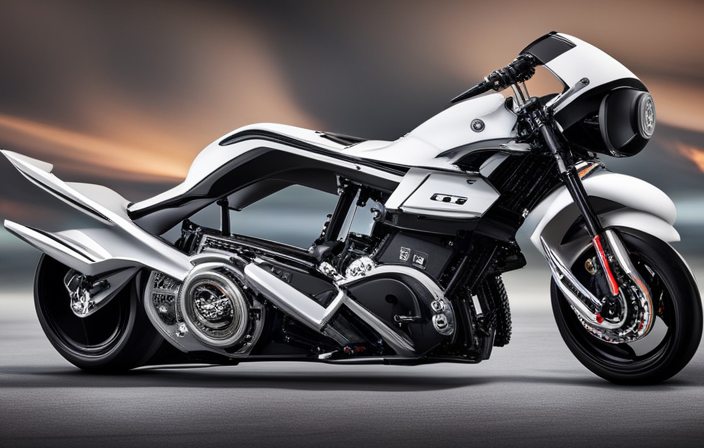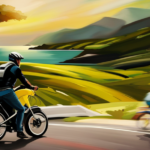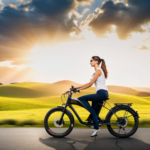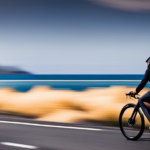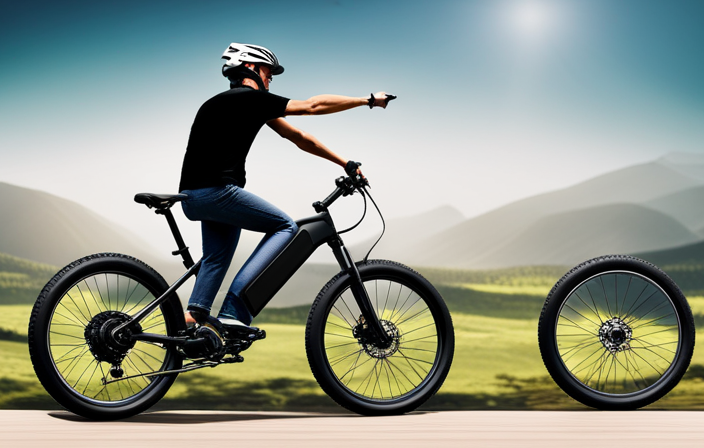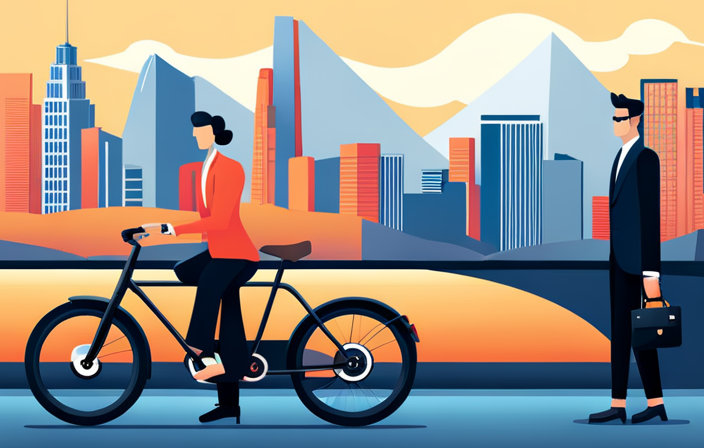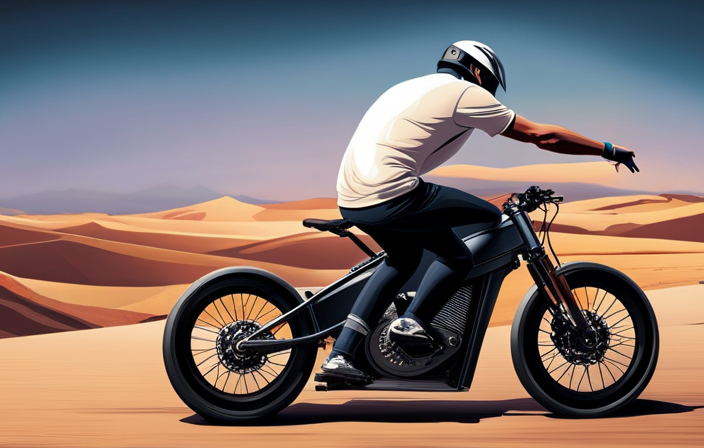Did you know that electric bikes can achieve impressive speeds without needing a license? In fact, some models can reach speeds as high as 28 miles per hour!
In this article, I will explore the various factors that influence electric bike speed, the legal speed limits, and how you can enhance the speed of your own electric bike.
Join me as we delve into the exciting world of electric bike speeds and discover the future possibilities they hold.
Key Takeaways
- Electric bike speed limits vary by country or state, ensuring safety for riders and other road users.
- The maximum speed of an electric bike is determined by its class: Class 1 has a 20 mph limit with pedal-assist, Class 2 has a 20 mph limit with throttle assistance, and Class 3 has a 28 mph limit with a higher speed option.
- Factors such as tire pressure, motor power, and weight distribution can affect electric bike speed, and optimizing these elements can enhance overall performance.
- Enhancing electric bike speed can be achieved through upgrading the motor and controller, speed tuning the controller, and other methods, but it is important to consider the legal classification and comply with appropriate licensing or registration requirements.
Understanding Electric Bike Speed Limits
Electric bikes have speed limits that vary depending on the country or state. These limits are put in place to ensure the safety of riders and other road users. While electric bikes are known for enhancing performance with the assistance of a motor, there are still speed restrictions that must be followed.
The specific speed limits can range anywhere from 20 to 28 miles per hour, depending on the location. It’s important for riders to familiarize themselves with the speed regulations in their area to avoid any legal issues. By adhering to these speed limits, electric bike riders can enjoy a safe and enjoyable riding experience.
Now, let’s explore the legal speed limits for electric bikes and how they can vary from place to place.
Legal Speed Limits for Electric Bikes
The legal speed limits for e-bikes vary depending on the jurisdiction. Understanding the legal requirements and speed limits in different countries is important for electric bike riders. To give you an idea of the variations, I have compiled a table below that shows the maximum speed limits for electric bikes in three different countries:
| Country | Speed Limit (km/h) |
|---|---|
| United States | 32 |
| Canada | 32 |
| United Kingdom | 25 |
As you can see, the maximum speed limits for e-bikes differ from country to country. It is crucial to familiarize yourself with the specific regulations in your area to ensure compliance and safe riding. Now, let’s explore the different speed classes for electric bikes.
Different Speed Classes for Electric Bikes
When it comes to electric bikes, there are different speed classes that determine their maximum speeds.
Class 1 electric bikes have a speed limit of 20 mph, while Class 2 electric bikes also have a 20 mph limit but come with throttle assistance.
Lastly, Class 3 electric bikes have a slightly higher speed limit of 28 mph.
These distinctions help both riders and authorities understand the capabilities and regulations associated with each class of electric bike.
Class 1 Electric Bikes – 20 mph limit
Class 1 electric bikes can reach speeds of up to 20 mph without requiring a license. Understanding speed classification and the speed restrictions for e-bikes is important when considering which type of electric bike to purchase.
Class 1 e-bikes are equipped with a pedal-assist system, which means that the motor only engages when the rider is pedaling. This allows for a more natural and efficient riding experience. The 20 mph speed limit ensures that class 1 e-bikes provide a safe and controlled ride, while still offering the benefits of electric assistance.
Moving forward, we will explore class 2 electric bikes, which also have a 20 mph speed limit but come with throttle assistance, allowing riders to achieve the maximum speed without pedaling.
Class 2 Electric Bikes – 20 mph limit with throttle assistance
With throttle assistance, riders of class 2 electric bikes can easily reach speeds of up to 20 mph. Understanding throttle control is essential for operating these bikes safely and effectively. To fully enjoy the riding experience, here are some key factors to consider:
-
Safety gear requirements: Wearing appropriate safety gear, such as helmets, knee pads, and gloves, is crucial to protect yourself in case of any unforeseen accidents.
-
Familiarize yourself with the throttle: Get comfortable with how the throttle works and how it affects the bike’s speed. Gradually increase the throttle to reach your desired speed.
-
Practice in a controlled environment: Find an open space or a designated area where you can practice and get a feel for the throttle control without any potential hazards.
-
Be mindful of your surroundings: Always be aware of your surroundings and other road users when riding a class 2 electric bike. Stay alert and follow traffic rules to ensure your safety and the safety of others.
As we transition into the next section about class 3 electric bikes with a 28 mph limit, it’s important to understand the increased speed and the additional safety considerations that come with it.
Class 3 Electric Bikes – 28 mph limit
To fully enjoy the increased speed of a class 3 electric bike, familiarize yourself with the safety considerations and regulations that come with riding one.
Class 3 electric bikes are capable of reaching speeds up to 28 mph, making them a popular choice for those who want a faster ride. However, it is important to understand the speed restrictions that may be imposed in your area. Some jurisdictions may have lower speed limits for electric bikes or require additional safety equipment such as helmets or mirrors.
Additionally, it’s worth noting that the speed at which you ride can have an impact on the battery life of your electric bike. Riding at higher speeds will drain the battery faster, so it’s important to consider this when planning longer rides or commutes.
Understanding these considerations will help you make the most of your class 3 electric bike and ensure a safe and enjoyable riding experience.
As we delve into the factors affecting electric bike speed, it becomes apparent that there are various elements that influence how fast these bikes can go without a license.
Factors Affecting Electric Bike Speed
You can increase the speed of your electric bike by adjusting certain factors. Understanding acceleration factors and the impact of weight on speed is essential. Here are some key points to consider:
- Tire Pressure: Maintaining optimal tire pressure ensures better grip and reduces rolling resistance.
- Motor Power: A more powerful motor will provide greater acceleration and higher top speeds.
- Weight Distribution: Balancing the weight on your electric bike evenly will help improve its stability and speed.
These factors play a significant role in determining how fast your electric bike can go. By optimizing these elements, you can enhance the overall performance and speed of your electric bike.
Transitioning into the subsequent section about enhancing electric bike speed, it is important to explore additional methods that can further improve your riding experience.
Enhancing Electric Bike Speed
By exploring additional methods, you can further improve the speed and performance of your electric bike.
One way to enhance your electric bike’s speed is by improving acceleration. Upgrading the motor and controller can provide more power, allowing you to accelerate faster and reach higher speeds.
Additionally, you can consider speed tuning your electric bike. This involves adjusting the settings on the controller to optimize the power output and achieve a higher top speed.
However, it’s important to keep in mind that modifying your electric bike’s speed may affect its legal classification and require appropriate licensing or registration. Therefore, it’s crucial to familiarize yourself with the regulations in your area before making any modifications.
Safety considerations at higher speeds include wearing appropriate protective gear, maintaining proper braking and handling capabilities, and being aware of your surroundings to ensure a safe and enjoyable ride.
Safety Considerations at Higher Speeds
When riding at higher speeds, it’s important to prioritize safety by wearing appropriate protective gear and maintaining proper braking and handling capabilities. Enhancing safety measures can have a significant impact on rider experience, ensuring a smooth and secure ride.
One way to enhance safety is by investing in reliable protective gear such as helmets, gloves, and knee pads. Additionally, it is crucial to regularly inspect and maintain your electric bike’s braking and handling capabilities. This includes checking the brake pads, adjusting the brake levers, and ensuring proper tire pressure.
Benefits of Electric Bike Speed Limitations
Enhancing safety measures can greatly improve the rider experience, ensuring a smooth and secure ride. One important aspect of safety on electric bikes is understanding speed control and its impact on the rider experience. By implementing speed limitations on electric bikes, riders can have a more controlled and enjoyable ride.
Speed control helps prevent accidents and reduces the risk of injury. It allows riders to maintain better control over the bike, especially when navigating through crowded areas or making turns. Additionally, speed limitations can also extend the battery life of the electric bike, allowing riders to travel longer distances without worrying about running out of power.
By prioritizing safety through speed control, electric bike manufacturers and riders can enhance the overall riding experience and promote a safer environment for everyone on the road.
With safety being a top priority, it is important to understand the laws and regulations for electric bikes.
Laws and Regulations for Electric Bikes
When it comes to electric bikes, it’s important to understand the laws and regulations that govern them at both the local and state levels. Local and state regulations can vary greatly, so it’s crucial to know what is allowed in your area in terms of speed limits, bike lanes, and where electric bikes are permitted to ride.
Additionally, there are international laws and guidelines that govern electric bikes, ensuring consistency and safety across different countries.
Local and State Regulations
To find out the speed limit for electric bikes in your area, check your local and state regulations. Electric bike speed regulations vary from place to place, so it’s important to familiarize yourself with the specific rules in your jurisdiction.
In some areas, there may be a maximum speed limit for electric bikes, while in others, they may be subject to the same speed limits as regular bicycles. Enforcement of speed limits for electric bikes also varies. Some areas have strict enforcement, while others may have more relaxed measures.
It’s essential to follow the speed limits to ensure your safety and comply with the law.
As we explore international laws and guidelines, we can gain a broader understanding of electric bike regulations beyond local and state jurisdictions.
International Laws and Guidelines
International laws and guidelines provide valuable insights into the regulations governing electric bikes beyond local and state jurisdictions. These laws and guidelines play a crucial role in exploring technological advancements and their impact on the transportation industry. They help us understand the global standards set for electric bikes, including speed limitations, safety requirements, and licensing regulations.
For instance, in some countries, electric bikes are classified as bicycles and do not require a license, while in others, a license might be necessary if the bike exceeds a certain speed threshold. These international regulations ensure consistency and safety in the use of electric bikes worldwide. Understanding these guidelines is essential for manufacturers, riders, and policymakers to ensure compliance and promote the responsible use of electric bikes.
With this knowledge, we can now transition into the subsequent section about speed records and electric bike competitions.
Speed Records and Electric Bike Competitions
If you want to know how fast electric bikes can go without a license, you’ll be interested in speed records and electric bike competitions. These events showcase the incredible speed capabilities of electric bikes and push the boundaries of what is possible.
Here are three key aspects of electric bike speed records and racing:
-
Electric bike speed records: Riders and manufacturers constantly strive to break speed records on electric bikes. These records serve as benchmarks for the fastest speeds that can be achieved. Currently, the fastest electric bike speed record stands at an astonishing 236.5 mph (380.8 km/h), achieved by electric bike builder, Lightning Motorcycles.
-
Electric bike racing: Electric bike competitions provide a platform for riders to showcase their skills and compete against each other. These races often take place on closed tracks or designated circuits. The races are thrilling to watch as riders navigate through corners and reach high speeds.
-
Continuous improvement: As technology advances, electric bikes are becoming even faster. Manufacturers are constantly developing more powerful motors, lightweight frames, and aerodynamic designs to enhance speed and performance.
With electric bike speed records being broken and electric bike racing gaining popularity, it is clear that the future of electric bike speeds holds exciting possibilities.
Exploring the Future of Electric Bike Speeds
As technology continues to advance, so do the motors and batteries used in electric bikes. These developments have the potential to greatly impact the speed capabilities of these vehicles.
In addition, these advancements may also lead to potential changes in speed limit regulations for electric bikes.
Technological Advances in Motors and Batteries
You can find electric bikes that have advanced motors and batteries, allowing them to reach higher speeds without requiring a license. The continuous development in motor technology and battery advancements has revolutionized the electric bike industry, providing riders with more power and longer range. Here are four key elements that contribute to the impressive performance of these bikes:
-
Powerful motors: Electric bikes are now equipped with high-performance motors that deliver instant torque, enabling faster acceleration and smoother rides.
-
Enhanced battery capacity: With advancements in battery technology, electric bikes can now carry larger battery packs, resulting in increased range and longer riding durations.
-
Efficient power management systems: Modern electric bikes utilize smart power management systems to optimize energy usage, maximizing the bike’s efficiency and performance.
-
Lightweight design: Manufacturers are constantly developing lightweight materials and components, reducing the overall weight of electric bikes while maintaining structural integrity.
These innovations in motor technology and battery advancements have led to electric bikes that can reach impressive speeds. However, these advancements also raise questions about potential changes in speed limit regulations, ensuring the safety of riders and pedestrians.
Potential Changes in Speed Limit Regulations
To ensure the safety of riders and pedestrians, it’s important to consider potential changes in speed limit regulations for these advanced electric bikes.
With the rise in popularity of electric bikes, it becomes crucial to address the potential safety concerns that may arise from their increased speed capabilities. These bikes, powered by advanced motors and batteries, have the potential to reach higher speeds than traditional bicycles. While this can be exciting for riders, it also raises concerns about the impact on traffic flow.
As electric bikes become faster, there is a need to reassess speed limits to ensure a harmonious coexistence with other vehicles on the road. Striking the right balance between allowing the benefits of increased speed and maintaining safety is essential in regulating electric bike speed limits.
Frequently Asked Questions
Can I ride an electric bike without a license?
Yes, you can ride an electric bike without a license, as long as it meets certain criteria like speed limits, power ratings, and age restrictions. However, there may still be riding restrictions and legal requirements to follow.
Are there any limitations on the speed of electric bikes?
Speed regulations for electric bikes vary by country and region. In some places, there may be a maximum speed limit of 20 mph, while others may allow higher speeds. It’s important to check local laws to ensure compliance.
What are the factors that can affect the speed of an electric bike?
Weight distribution and battery capacity are two key factors that can affect the speed of an electric bike. Proper weight distribution helps maintain stability, while a higher battery capacity allows for more power output, resulting in increased speed.
Are there any safety considerations when riding an electric bike at higher speeds?
Safety should always be a priority when riding an electric bike at higher speeds. It’s crucial to wear proper safety gear like helmets and protective clothing. Additionally, regular maintenance is essential to ensure optimal performance and safety.
Are there any benefits to having speed limitations on electric bikes?
Removing speed limitations on electric bikes has pros and cons. On one hand, it allows for faster speeds and increased performance. On the other hand, it raises safety concerns and could potentially impact sales and adoption due to stricter regulations.
Conclusion
In conclusion, electric bikes offer a thrilling and efficient way to travel. Riders can enjoy the freedom of the open road without the need for a license, thanks to the various speed classes and limitations of electric bikes. Factors such as weight, terrain, and battery power can affect an electric bike’s speed. However, riders can enhance their speed by upgrading components and optimizing their riding style.
While there are laws and regulations in place to ensure safety, the future of electric bike speeds holds exciting possibilities. So, hop on your electric bike and embrace the exhilarating journey ahead!

